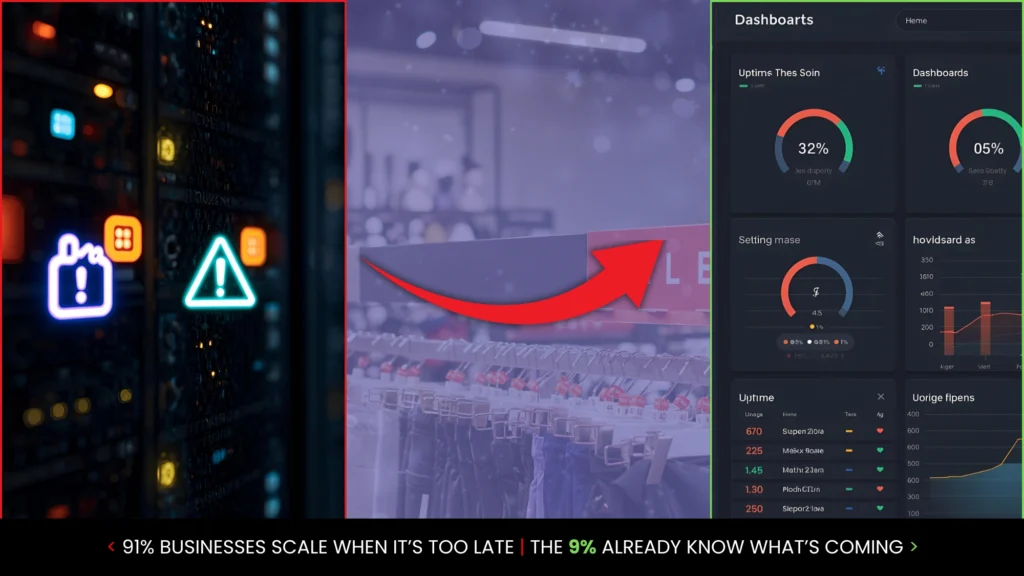How Predictive Autoscaling Helps You Survive (and Win) the 2025 Holiday Surges

- What Is Predictive Autoscaling?
- Predictive Autoscaling: The Business Benefits
- How Cloud Autoscaling Works in the Holiday Season
- Traditional vs Predictive Autoscaling Across Major Cloud Providers
- Getting Started — How to Implement Smart Scaling Fast
- Why You Might Need Cloud Scaling Solutions
- From Scaling to Strategy: The Competitive Edge in 2026
- The Future of Predictive Cloud Scaling
- Act Now – Before the Holiday Rush Hits
- FAQs
“Customers just skip to competitors when websites crash during festive rushes.”
Every holiday season is a high-stakes stress test for digital businesses. In 2024 alone, online traffic during Black Friday spiked over 250% globally — and even a one-second delay caused up to 9% loss in conversions.
The real challenge? Most systems react after the spike hits. In 2025, that’s too late. This is the year cloud strategies must predict demand before it happens — not just scale up when it’s already too late.
That’s where predictive autoscaling — and Infosprint’s cloud strategy expertise — comes in. At Infosprint Technologies, we help organizations turn traffic into a competitive advantage, forecast demand and keep every customer journey seamless, no matter how unpredictable the surge.
What Is Predictive Autoscaling?
Predictive autoscaling is an advanced cloud capability that uses machine learning (ML) and time-series forecasting to anticipate changes in demand and automatically scale resources before a traffic spike occurs.
Traditional autoscaling reacts only when system metrics (like CPU or memory) cross certain thresholds. By then, your users may already be experiencing slow pages or timeouts.
Predictive autoscaling, on the other hand, examines historical traffic patterns, seasonal behavior, day-of-week variations, and external signals (such as marketing campaigns or holiday calendars) to forecast when demand is likely to increase. It then pre-provisions compute, storage, and network capacity just in time to absorb the surge.
For Instance:
If your retail app experiences a 250% traffic increase every Friday evening and an even sharper rise on Black Friday, predictive autoscaling will scale out your servers on Thursday night — ensuring there’s zero lag when customers flood in.
It’s like having a data-driven “forecast engine” that keeps your cloud one step ahead.
Predictive Autoscaling: The Business Benefits
The holiday season amplifies both opportunity and risk. Demand surges are predictable in terms of timing but unpredictable in terms of scale. Predictive autoscaling bridges that gap between readiness and efficiency.
For reference, Harvey Norman’s e-commerce platform went down during Black Friday 2023, resulting in an estimated 60% loss of online sales for the day.
Here’s why it’s becoming indispensable for modern businesses:
1. Keeps Customer Experience Consistent
Your website’s speed and responsiveness have a direct impact on sales. Delays of even one second can lower conversions by up to 9%. Predictive autoscaling ensures that customers enjoy a smooth, uninterrupted experience, even during flash sales or viral promotions.
2. Prevents Revenue Loss from Downtime
Every minute of downtime during peak traffic can result in thousands of dollars in missed transactions. By scaling ahead of the curve, predictive autoscaling helps you stay online when competitors crash.
3. Balances Cost and Performance
Many companies still over-provision infrastructure “just to be safe.” Predictive autoscaling changes that. It scales just the right amount of resources at the right time, minimizing waste while maintaining reliability.
4. Empowers Operations and DevOps Teams
With predictive scaling in place, your IT teams can focus on innovation rather than firefighting. It automates capacity decisions that once required constant monitoring.
5. Gives You a Competitive Edge
In peak seasons, user trust is everything. If your platform stays fast, stable, and available while others slow down, customers remember. Predictive autoscaling becomes your silent differentiator — the backbone of a superior festive-season experience.
6. Reduces Checkout Failures and API Bottlenecks
By preparing your backend services ahead of time, predictive autoscaling ensures that APIs remain responsive and checkout processes remain smooth, even under extreme load.
7. Protects Your Brand Reputation
Nothing erodes customer trust faster than a “Service Unavailable” message during a festive sale. Predictive autoscaling prevents those brand-damaging moments.
Beyond performance, festive surges also attract a rise in cybersecurity threats, such as social engineering. Discover how social engineering tactics evolve during holiday sales and learn practical strategies to protect both your infrastructure and your customers.
How Cloud Autoscaling Works in the Holiday Season
At its core, predictive autoscaling combines analytics, automation, and forecasting.
- Data Collection:
The system collects metrics, including CPU usage, request rates, database latency, and seasonal user behavior, from monitoring tools and logs. - Forecasting:
It applies time-series ML models (like ARIMA, Prophet, or in-built cloud algorithms) to predict workload demand hours or days in advance. - Scaling Decision:
Traditional autoscaling reacts after a surge begins, causing a lag as new resources boot up. Predictive scaling eliminates that delay, so your users never notice the spike. Based on these forecasts, the autoscaler determines the number of instances, containers, or functions required. - Pre-Provisioning:
The cloud platform automatically launches (or warms up) resources before demand increases, ensuring seamless capacity availability. - Continuous Learning:
As the system observes new data, it refines its models for improved accuracy — making it smarter with each passing season.
How Major Cloud Providers Support It
- AWS: Predictive Scaling for Auto Scaling Groups uses ML to forecast and add EC2 capacity proactively.
- Azure: Virtual Machine Scale Sets can integrate predictive models and schedule-based rules.
- Google Cloud: Predictive Autoscaling for Managed Instance Groups pre-scales VMs to handle forecasted load.
Whether you’re operating on AWS, Azure, or Google Cloud, implementing predictive autoscaling requires a foundation built on robust architecture. Our cloud computing services help businesses design scalable, high-availability environments that are ready for any surge in demand.
Traditional vs Predictive Autoscaling Across Major Cloud Providers


Getting Started — How to Implement Smart Scaling Fast
Even if you’re new to predictive scaling, there are doable actions that you can take now.
Step 1: Start with Historical Load Analysis
- Gather data from the last 6–12 months: traffic spikes, CPU utilization, API calls, and sales events.
- Identify recurring trends — such as specific hours, days, or campaigns that drive demand.
- Use your analytics dashboards (such as Datadog, CloudWatch, or Azure Monitor) to visualize these peaks.
This step helps your system learn what to expect and when to expect it.
Step 2: Enable Built-In Predictive Scaling Tools
Most cloud platforms now provide advanced predictive features:
- AWS Auto Scaling: Enable Predictive Scaling policies on EC2.
- Google Cloud: Turn on Predictive Autoscaling for Managed Instance Groups.
- Azure: Combine scheduled scaling with AI forecasting via Azure Machine Learning integration.
If you’re deciding which platform aligns best with your business goals, our detailed comparison of AWS, Azure, and GCP breaks down their strengths, costs, and scalability options.
Set up your scaling policies to pre-warm:
- Frontend web servers
- API Gateways
- Databases and caching layers
- Serverless functions that handle checkout or payment flows
Run a load test simulating peak conditions before your campaign — this ensures your scaling configuration behaves as intended.
Why You Might Need Cloud Scaling Solutions
Sometimes, decision-makers underestimate the impact of scaling until it’s too late. Let’s explore common pain points that predictive autoscaling solves — and why it matters even for smaller businesses.

The Real-World Impact
In late 2025, several mid-tier retailers over-provisioned by nearly 60% for Cyber Monday, spending far more than necessary — yet still experienced lag due to uneven scaling across services. Predictive autoscaling would have balanced cost and performance, provisioning the right capacity where it was needed most.
Predictive autoscaling isn’t about spending more — it’s about spending smarter.
From Scaling to Strategy: The Competitive Edge in 2026
As cloud ecosystems evolve, the battle for performance and efficiency is moving toward intelligence-driven scaling. Businesses that embrace predictive autoscaling gain several strategic benefits:
- Operational Stability
- Your infrastructure automatically adjusts to traffic variations, freeing teams from manual interventions.
- Your infrastructure automatically adjusts to traffic variations, freeing teams from manual interventions.
- Cost Predictability
- By forecasting both demand and resource use, predictive scaling also informs your FinOps strategy — helping you anticipate cloud costs during peak events.
- By forecasting both demand and resource use, predictive scaling also informs your FinOps strategy — helping you anticipate cloud costs during peak events.
- Better Observability
- When combined with real-time monitoring, predictive autoscaling provides teams with a unified view of performance, enabling faster incident response and resolution.
- When combined with real-time monitoring, predictive autoscaling provides teams with a unified view of performance, enabling faster incident response and resolution.
- AI-Driven Agility
- Predictive autoscaling can integrate with AIOps platforms, automating not just scaling, but also alerting, anomaly detection, and performance tuning.
- Predictive autoscaling can integrate with AIOps platforms, automating not just scaling, but also alerting, anomaly detection, and performance tuning.
- Customer Loyalty
- Seamless digital experiences lead to higher trust and repeat business. In a competitive market, uptime and speed often win over discounts.
The Future of Predictive Cloud Scaling
Predictive autoscaling is just the beginning of autonomous cloud operations — systems that forecast, adapt, and optimize themselves with minimal human input.
In 2025, we’ll see this technology evolve beyond scaling:
- Predictive FinOps: Automated budget adjustments based on projected usage trends.
- Predictive Caching: AI-driven caching layers that pre-load high-demand assets.
- Predictive Failover: Systems that detect and mitigate failures before they impact users.
As these capabilities mature, businesses that adopt predictive scaling early will already have the foundational data, automation, and agility needed to stay ahead.
Act Now – Before the Holiday Rush Hits
Holiday seasons don’t wait — and neither should your infrastructure.
Predictive autoscaling ensures that your cloud environment is always one step ahead, balancing performance, cost, and customer satisfaction. It’s not just a technical upgrade; it’s a competitive advantage that defines which brands thrive during high-traffic events.
The festive season brings both peak traffic and cyber threats. Learn how fake sites steal payment data and how to protect customers.
In 2025, success won’t depend on who has the biggest infrastructure — but on who scales smarter and protects their customers better.
Now’s the best time to prepare for your next festive surge.
Start by analyzing your past traffic trends and enabling predictive scaling in your environment — before your customers (and competitors) remind you why it matters.
Ready to prepare your cloud for the next festive surge? Get in touch with our cloud architects for a readiness assessment.
Frequently Asked Questions
It addresses checkout failures, cold-start latency, and over-provisioning costs by pre-scaling infrastructure before surge events.
Systems typically require at least a week of data and often more (e.g., 7–15 days) to establish reliable forecasting.
Yes, by scaling resources just in time for demand, it avoids both under-provisioning (performance issues) and over-provisioning (wasted cost).
Ideally several weeks before major sales events—giving time for data collection, testing, and tuning scaling policies.
No, any business experiencing traffic surges (holiday sales, product launches, regional peaks) can benefit from predictive autoscaling.
Related Blogs

Top 3 Tech News in October 2025 Impacting Your Business Strategy in 2026

Hiring for Emerging Tech Roles in 2026: Find the Right AI, Cloud, and Cybersecurity Talent




